|
|
Ormonde

|
|
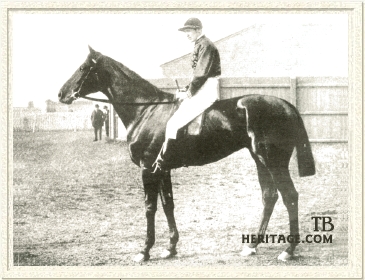 |
|
|
Ormonde was unbeaten as a racehorse, and in spite of developing a wind infirmity he included the English Triple Crown races among his victories. He was said to be the finest racehorse of the 19th century, and perhaps of all time. In an era before airlines, he got foals on three continents and two hemispheres, despite being almost infertile. His brilliant English son, Orme, added another Triple Crown winner to the sire line by getting Flying Fox, and another Derby winner in Orby.
Ormonde's sire, was the golden Derby winner Bend Or, bred and raced by the Hugh Lupus Grosvenor, the Duke of Westminster, at his Eaton Stud near Chester, England. When Bend Or's racing days were over, he retired to stud at Eaton, becoming highly influential as a sire, not only through Ormonde, but through the Two Thousand Guineas winner Bona Vista, the sire-line great-grandsire of Phalaris, now the predominant thoroughbred sire line in the world. Bend Or's daughters produced such greats as Sceptre and, in the U.S., Fair Play.
Ormonde's dam, Lily Agnes, was by Derby winner Macaroni. She was a grand stayer, winner of nineteen races, including the Great Ebor Handicap and the Doncaster Cup, and she was also a wonderful broodmare. In addition to Ormonde, her fourth foal, she produced the One Thousand Guineas winner Farewell, stakes winners Ossory and Fleur de Lys, and Ormonde's sister, Ornament, who became the dam of the outstanding race mare Sceptre.
Ormonde was the beneficiary of a great pedigree that included two excellent winning parents, a wealthy owner who could afford the best of everything for his animals, and one of the era's best trainer, John Porter. He was an ungainly foal, born over in the knees after a twelve month gestation, and he was not one of the Duke's favorites as a youngster. He was sent to Porter's Kingsclere Stables as a yearling, and by age two he had developed into a horse with excellent bone, straight hocks, a well-laid back shoulder, and short, powerful quarters that later led some to call him a racing machine. His neck, Porter later said, "was the most muscular I ever saw a Thoroughbred possess." His ears "were inclined to lop. The width of his head behind the ears was remarkable; I never came across another horse that showed this characteristic to such an extent." His action at slower gaits was not impressive, but when galloping "he carried his head rather low and covered an amazing lot of ground at each stride when extended." He grew to 16 hands. He inherited the kind temperament of his sire, Bend Or, and was a "great doer" with "a wonderful constitution." He would eat anything that was offered him, and, according to Porter, was particularly fond of flowers, which he was happy to snatch from the boutonniere of any unsuspecting gentleman that happened to be within reach.
Ormonde did not race until the fall of his juvenile year, when he won the Post Stakes, defeating the well-seasoned filly Modwena. He went on to win the Criterion Stakes by three lengths, and two days later won the Dewhurst Stakes, beating a field of ten, including his stablemate, Whitefriar. That was the end of his two-year-old season.
At age three he came out for the Two Thousand Guineas, defeating the unbeaten Minting by two lengths; Minting went on to win the Grand Prix de Paris later that season. The field of nine in Ormonde's Derby was the smallest since 1804, largely because it seemed a given that he would win it, which he did, besting the unbeaten, 16-race winner The Bard by 1-1/2 lengths. He went on to win the St. James's Palace Stakes and the Hardwicke Stakes at Ascot, and then the Doncaster St. Leger, "untouched by whip or spur," winning in a canter by four lengths. With this victory he became the fourth horse to win the English Triple Crown.
|
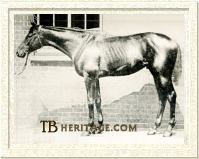
Ormonde in racing trim
| |
He journeyed on to Newmarket, where he won the Great Foal Stakes, carrying 131 pounds and beating Mephisto, weighted at 124 pounds, by 3 lengths. In the Champion Stakes he beat Oberon, and at Newmarket Houghton he again beat Mephisto in the Free Handicap by eight lengths, spotting him 28 pounds. The day after the Free Handicap he walked-over for the Private Sweepstakes, with Melton and The Bard paying forfeit. It was the final race of his triumphant second season, but all was not well with Ormonde. Porter had noticed a slight whistling just before the St. Leger, and the sound progressed after that. During his winter lay-off he was "electrically treated" for it, but it was clear in the spring that he was now a roarer (as had been his dam, Lily Agnes).
|
All were anxious regarding his four-year-old season, but he came out for the Rous Memorial Stakes at Ascot, and giving Kilwarlin (that year's St. Leger winner) 25 pounds, won by at least six lengths --many, including Porter, claimed it was twelve lengths. The next day was the Hardwicke Stakes again, and this time he faced a seasoned Minting on the 1-1/2 mile course, the last mile of it uphill. Ormonde experienced interference from the horse Phil, but overcame it, although for the first time ever he felt the whip to keep him ahead. On the final uphill climb, he held off Minting's challenge, his "choking fight for breath...heard all over the racecourse, and the crowd watched in stunned silence as he called upon his last reserves of strength." He won by a neck, beating Minting and Bendigo, and the crowd went wild. The Duke led Ormonde around the paddock twice and the crowd continued to cheer until Ormonde was out of sight enroute to the stables. It was, said Porter, "the greatest display of enthusiasm ever seen on a racecourse." His last race was the Imperial Gold Cup at Newmarket July, defeating Whitefriar by two lengths. He had won all fifteen high-class races he had entered in his career, many of them by a distance and giving away weight. Porter said Ormonde was the greatest horse he had ever known.
Ormonde was dubbed "the Horse of the Century," and was the toast of England, and of racing society world-wide. After his last race he was guest of honor at a garden party hosted by the Duke at his Mayfair mansion to celebrate Queen Victoria's Jubilee. He was sent by train to Waterloo Station and walked through London to Mayfair, with special permission, to stand, like the gentleman he was, in the Duke's Grosvenor House garden, receiving the adulation, caresses, and flowers of queens and princes. So it was a shock to many that after two seasons at stud in England, even before his first crop had started running, that the horse that had done everything asked of him with "courage and brilliance" was sold to Argentina.
Ormonde in the Stud
Ormonde retired to Eaton, and in his first season got seven foals from the sixteen mares he covered, including ORME, from the unraced Angelica, and GOLDFINCH. In his second season in 1889, with Eaton's paddocks full, and Bend Or still the predominant stallion there, Ormonde was leased to Lord Gerard and stood at Moulton Paddocks at Newmarket. There he was very ill, and could only service a few mare; when 1890 rolled around, only one foal of his, GLENWOOD (later a winner, out of Maid of Dorset by Dutch Skater), hit the ground. He was still sick and weak when Richard Chapman, Eaton's stud groom, went to collect him in the summer of 1889, although he managed to walk the two miles to the station for entrainment back to Eaton. His health improved steadily at Eaton, but that illness was blamed for his subsequent infertility, not truly evident until his first small crop of Argentinian foals.
In England he left eight foals, only two of which did not win races. ORME and GOLDFINCH were both high-class runners, and KILKENNY (Trustful Plate at age 4, dam's sire of good French runner Grignouse), LLANTHONY and SORCERER were winners. His daughter ORONTES ((1889) became the tail-female ancestress of a number of good stakes winners in France. But their victories were a few years down the line, and the Duke was on the lookout for a purchaser for Ormonde; he already had his very successful sire, Bend Or, at Eaton, and it should be remembered that the Duke unsentimentally let the great Doncaster go to Hungary after Bend Or was firmly established as a stallion. It was generally bruited about that the Duke did not keep Ormonde because he had developed into a roarer, and the Duke was determined to not inflict that "infirmity" on the breeding population of English thoroughbreds by risking foals that might also develop into roarers. A number of sources claim the Duke said something like this, although Chapman, in an interview, seemed to indicate it was an excuse manufactured for, rather than by, the Duke. Other sources speculate that the Duke already knew Ormonde was mostly infertile, although in the same interview Chapman indicated the first season and crop was "perfectly normal," and the sole mare in foal in 1889 was attributed to Ormonde still being ill. In any case, the Duke received an offer of £12,000 from Juan Salvador Boucau of Argentina, which was accepted. Chapman later said he believed the Duke hoped "the poor horse," as he called him, would benefit from the "warmer, drier climate" in Argentina. Throughout the summer of 1889 Ormonde was walked for five or six hours daily, to get him fit for his overseas journey. He was shipped out in the fall of 1889, and a little over a month later, arrived in Buenos Aires "...perfectly fresh, and in a letter we received we were informed that directly he landed he neighed loudly, as much to say 'Here I am."
|
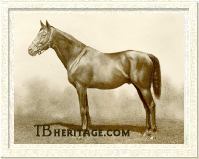
Orme
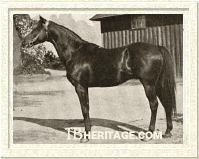
Goldfinch
| |
ORME (1889) was bred at Eaton, out of Angelica, a sister to St. Simon. Sent to Porter at Kingsclere, he won his first outing as a juvenile, Goodwood's Richmond Stakes, and went on to win four of his next five races, including the Middle Park Plate and the Dewhurst Plate. He missed the Guineas and the Derby because he was ill, so his first race at age three was Sandown's Eclipse Stakes, which he won, and he also took Goodwood's Sussex Stakes, and four races at Newmarket, including the 1-1/4 mile Champion Stakes and the 6 furlong Subscription Stakes. He failed to place in the St. Leger. At four he won the Rous Memorial, Eclipse and Gordon Stakes; his suspensory gave way in the running of the Limekiln Stakes at Newmarket, ending his career. He was retired to Eaton, where he got three classic winners, including English Triple Crown champion Flying Fox, who continued the sire line.
GOLDFINCH (1889), bred by Lord Alington, was out of Thistle, by Scottish Chief. She had won the Findon Stakes and other races, and was also the dam of Triple Crown winner Common, of St. Leger winner Throstle, and of the filly Thistlefield, dam of Landrail, winner of the Rous Memorial, Doncaster Stakes, Great Northern St. Leger and other races, and Bettyfield, a good juvenile winner of the Predergast and Fitzwilliam Stakes.
|
Goldfinch ran three times as a juvenile, winning the Kempton Park Bienniel and Ascot's New Stakes, defeating Bona Visa and eight others, and was beaten by a head in Newmarket's July Stakes. At age three he failed to place, and was retired to stud. In his first year at stud he got Chelandry, the top juvenile of her generation, and winner of the One Thousand Guineas at age three; in the stud she produced five stakes winners, including Two Thousand Guineas winner Neil Gow. Some other useful horses by Goldfinch that ran in England, included Tippecanoe, Hawfinch, Chesable, Reese and Monterey.
In 1894 James Ben Ali Haggin paid 4,000 guineas for Goldfinch, and sent him to his vast Rancho del Paso stud in California's Sacramento valley. Supported by Haggin's huge band of broodmares, he was a useful sire of a number of winners, including Old England ($20,000, Preakness Stakes), Cunard ($20,610, Kenner Stakes, later a sire at Idle Hour Stock Farm, making the top 20 in the leading sire's list several times), Tradition ($40,470, winner of the Gazelle, Mermaid and Brighton Oaks Stakes), Song and Wine ($24,105, Sheepshead Bay Double Event Part I, Belmont Juvenile Stakes), Sweet Lavender, Killashandra, and a number of others, including Gold Van, a stakes winner at age three, and a winner over jumps at age five. Haggin also shipped some Goldfinch youngsters to England, including Faisan d'Or, Nevada, Bronzewing, and about two dozen others. In 1904 Goldfinch was seventh on the U.S. leading sire's list, and made the top twenty list in two succeeding years, but never attained the success of some of Haggin's other stallions, such as Watercress and Star Ruby (from Ormonde's sister, Ornament). He was moved to Elmendorf in Kentucky when Haggin left California, and was, along with Haggin's other stallions, offered to outside mares for the first time after arriving there. He died in 1914. |

|
Ormonde got very few foals in Argentina, and none that left a lasting mark on the breed. He was put to some well-bred mares his first season of 1890, mares by Petrarch, Umpire, and Hermit, among them. He got a dismally small crop in 1891, from the number of mares serviced, and this continued the following year. Further, they were generally unsuccessful runners and not especially useful in the breeding shed: four of his approximately 20 foals in Argentina were winners--LOWLAND BOY (1893, from Lowland Maid by Lowlander), and the fillies TORRE DE MARFIL, LADY ORMONDE (1891, from Lady Florence by Chester), and PELO DE ORO (1892, from the Lord Lyon mare, Girdle). Lady Ormonde, bred on, and had a tail-female descendant stakes winner in the 1960s. Lowland Boy got some runners, and one of his sons, Edward Low, imported into Chile in 1906, served as a very modest stallion there.
[Somewhat ironically, it was an undistinguished son of Ormonde's foaled in England, ORVILLE (1889, from Derby winner Shotover), imported by Guillermo Kemmis for his Las Rosas Stud in Argentina, who did well as a sire there. His daughter, Muneca (1896), became tail-female ancestress of some good Argentine racehorses, including Gran Premio Carlos Pellegrini winner Montubio (1985), Frisky (1956), winner of the Gran Premio Seleccion and other races, and Larrea (1907), a great racing colt who won the Polla de Potrillos, the Gran Premio Seleccion, the Premio General Pueyrredon and other good races.]
However, Sr. Boucau's investment was about to pay off, although not in a way he might have anticipated. As the 1891 racing season in England progressed, it became clear that, despite his roaring, Ormonde was capable of getting really first class performers, as both Goldfinch and Orme were proving to be in their juvenile years. J. Hume Webster of Marden Deer Park attempted to put together a syndicate in England to repurchase Ormonde, whose low fertility was as yet unknown to them. Of course, the successes of Ormonde's first crop in England did not escape Boucau's attention, either, and he let it be known Ormonde could be had, for a price. Hume could only secure twenty subscribers for three seasons, at 300 guineas per mare, but Boucou wanted at least £32,000 for the horse, and when Hume failed to find more subscribers, the plan to repatriate Ormonde fell through.
But word of Ormonde's availability reached the U.S., and attracted the particular attention of two breeders, Charlie Reed, owner of the Fairview Stud in Tennessee, and William O'Brien Macdonough, who had inherited a great deal of money from his father, an importer and shipper of coal, coke and pig iron; Macdonough's aunt was married to William O'Brien one of the "Big Three" of the Comstock (silver) Lode. Macdonough had established the Menlo Park Stud on the San Francisco Bay peninsula, which to that time had not been particularly successful in producing good runners. Reed had recently purchased the Hermit son St. Blaise (leading sire in 1890) from the Belmont dispersal for $100,000, shutting out the bidding for the stallion by jumping to that price when the horse first came under the gavel. There are several versions of the story regarding how Macdonough was able to outbid Reed and secure Ormonde in the winter of 1892-3. Sr. Boucau received $150,000, an unprecedented sum for any horse at that time, and Macdonough spent close to another $25,000 getting Ormonde to California, since the horse first had to be shipped to England, and then back across the Atlantic to the U.S., because there were no reliable vessels -- at least none worthy enough of carrying such an investment -- making the the trip directly between Argentina and the U.S.
|
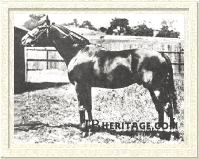
Ormonde in California
| |
So Ormonde was sent back to England in the summer of 1893, and after arriving at Southampton, was sent to the Duke of Richmond's Goodwood estate to recuperate before continuing on his journey to California. His old trainer, John Porter, met his boat, and visited him for the last time at Goodwood before he shipped out again, pulling "...a few hairs out of his mane and tail which I have preserved as a memento of a great and noble creature." Ormonde went by steamer to New York, and from there by rail to California, arriving late in 1893.
|
Ormonde's first foal in California was actually conceived in England during Ormonde's brief stop-over there, and imported in-utero by Macdonough, who had purchased his dam, the stakes winner Kissing Crust (by Sweetbread), and two other open mares in England to be covered by Ormonde before he made his trip back across the Atlantic to Macdonough's stud. The other two mares were Maiden Belle, by Beau Brummel, and Mirage, by Speculum. Kissing Crust's foal was ORESTES (1894). Maiden Belle arrived open, with Santa Bella, her 1893 filly foal at side. Santa Bella later became the dam of ORMONDALE. Mirage, imported with her daughter Miss Brummel, by Beau Brummel, died in 1894; it is not indicated whether she was in foal at the time. So Orestes was the only Ormonde foal of 1894, and he was purportedly a promising colt, until he stepped on a nail while in training at Sheepshead Bay Track in 1897, and died of lockjaw.
Ormonde's next crop (1895) included only two foals, both bred by Leland Stanford's widow, Jane Stanford, owner of the nearby Palo Alto Stock Farm. She and Macdonough had come to an agreement wherein she would send ten mares to Ormonde, with no stud fees paid; she would keep the fillies, and Macdonough the colts. The foal out of the imported mare Getaway died. Imported Fairy Rose (by Kisber) was the other Stanford mare, later dam of the great runner Racine and the high-class Fairy. The Ormonde foal out of Fairy Rose was a bay filly, named ROSORMONDE. She was a useful runner for the Pueblo Stables of J. Naglee Burke's in San Jose, winning three of ten starts as a juvenile; four of twenty-four at age three; seven out of 29 starts at age four, including two Free Handicaps, the May Day, Paxton and Christmas Handicaps; three of 19 starts at age five, including the Gunst Handicap.
|
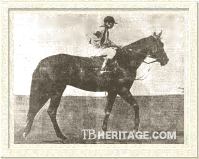
His grandson Sir Wilfred extended his sire line through several generations
| |
In 1896 there were only four youngsters, from twenty mares serviced: two colts and two fillies, all from mares owned by Macdonough. Only the colts raced, and neither won. OSSARY (Countess Langden by Kingcraft) was later a useful sire at Macdonough's stud, his son, Sir Wilfred, a good stakes winner -- beaten only once as a juvenile -- owned by Charley Durnell, and through him Ormonde's sire line continued on a slender thread for several generations: Sir Wilfred (1903, from Plumeria) got a Futurity winner in Trojan (1912, sire of Solace, Indiatown and Cayuga), and Trojan got a runner, Desperate Desmond (1921, an extremely modest sire) who also got a Futurity winner in Kerry Patch (1930, winner of $105,660), later a useless stallion in Maryland.
|
The second Ormonde foal in 1896 was ORSINI (Jongleuse by Alarm), after an undistinguished turf career, became stallion at Macdonough's stud, and got a very good runner in George C. Bennett (Bashford Manor Stakes. Sheepshead Bay Double Event Part I, and others, from the dam of GOLD LACE and HONITON), but was basically a modest sire, although he is still seen in pedigrees of stakes winners through a daughter, Roselawn. The other two youngsters from this crop were fillies: GOLDEN LOCKS (Dizzy Blonde) eventually produced the useful sire (in California) General Roberts (1901), and ORELLANA (Marilee by Glengarry) bred Coronal.
There were four fillies in 1897, a fifth, Artemis, probably by St. Carlo, rather than Ormonde. Of these, ORTHIA (out of Wildidle daughter Muta) was a winner, and later ended up in the stud of Harry Payne Whitney. OREMUS was from Santa Cruz out of a Norfolk daughter, Eliza. GOLD LACE (from the Belmont-bred Libbertifflibbet by the in-bred (to Lexington) Bullion) won at Morris Park, New Jersey, and was later the dam of some stakes winners. ROSE OF ORMONDE (out of Bud, by Glenmore) went unraced; she was tail-female ancestress of the great staying gelding Great Communicator (1983), winner of the Breeders' Cup Turf Stakes, the San Juan Capistrano Handicap, and the Hollywood Turf Cup, and of the "Hill" horses, including Hill Rise (1961, Queen Elizabeth Stakes, Santa Anita Handicap, etc.), Hill Run (1966, Prix Jean Prat) and Hill Circus.
In 1898 only one foal by Ormonde was dropped, BEAU ORMONDE, out of Miss Brummel, the filly Macdonough had imported in 1893 with her dam, Mirage. This chestnut colt ran as a juvenile in the east, winning the First Monday Handicap at Morris Park; back in California at age three, he won a High Weight Handicap at San Francisco and a Free Handicap at Tanforan, two of his four wins in 22 starts. He won three races from twelve starts at age four, and then was sold to Mrs. E.L. Kripp, for whom he won eight of his 32 races at age five, and five of his 18 starts at age six, at Hawthorne Park and other Illinois venues, all at the handicap level.
The sole Ormonde foal of 1899 was ORATOSSA, bred by A.B. Spreckles from an imported Australian mare, Atossa, by Dunlop. She raced, but did not win.
Two foals arrived in 1900, a filly, ORBONA (Partisana, by imported Partisan), who went unraced, and the brown filly HONITON, a sister to GOLD LACE, who was a stakes winner in California for Macdonough. She won three races from 17 starts at age 2, and six of her 11 starts at age three, including two handicaps. In 1904-5 she ran under the colors of Macdonough's trainer, P. Ryan, winning five races in each of those years.
In the fall of 1899 Ormonde was sent to James Ben Ali Haggin's Rancho del Paso in the Sacramento Valley, joining his English-bred son, Goldfinch there, in the hope that a change in climate, and possibly supervision by Haggin's stud master, John Mackey, might somehow improve Ormonde's fertility, and he stayed there until the spring of 1904. That didn't work. There were four foals in 1901, three of which were attributed to Ormonde or one of Haggin's stallions under succeeding covers. Those three were Ormondine, by Ormonde or Star Ruby, Phantasma, by Ormonde or Golden Garter, and Bronx, by Ormonde or St. Gatien. The only one who could be certainly attributed to Ormonde was the colt, ORMONDE'S RIGHT, out of a Haggin mare, Right, by Onondaga. This colt, later gelded, passed through a number of hands during his five years on the turf; he won the Neptune Stakes at Brighton Beach, the Autumn Maiden Stakes at Coney Island, and a handicap at Morris Park as a juvenile; his other wins included handicap wins in New York, including Aqueduct's Carter Handicap, and other handicaps elsewhere in the east, including the Norfolk Purse at Toronto and the Rennert Handicap at Baltimore. He won over 20 races in over 93 starts during his career.
In 1902 the sole foal was a filly, EVERETTA, out of the Rancho del Paso mare Lady Marion, by Sir Modred, but she was also listed as under a second cover by Haggin's St. Gatien. She went unraced. The next year, 1903, was another one-foal year, but this time it was ORMONDALE. After years of disappointment and great expense, Macdonough finally had that one youngster that justified his purchase of Ormonde, and in fact Macdonough soon changed the name of his stud farm to Ormondale Stock Farm.
|
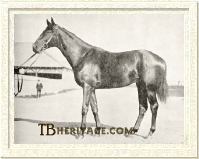
Ormondale
| |
ORMONDALE (1903) was the only high quality runner from Ormonde's sparse California crops. He was out of the St. Serf daughter, imported Santa Bella. He won the Futurity Stakes, the most important race for juveniles in the U.S., and placed third in two other races that season. At age three he won the 1-1/16 mile Broadway Stakes, and was second in the Standard Stakes, and placed in a few other races and then was retired to stud. A handsome horse, he got an even more impressively beautiful son in Purchase, who at age three won nine of his eleven races, including the Dwyer Stakes, beating Sir Barton, the Empire City Derby, the Saratoga, Saranac and Huron Handicaps, and the Jockey Club Stakes, most under incrediby high imposts. Ormondale also got Ordinance, another good three-year-old. Purchase got 5 stakes winners from 74 runners, his best a 1930 filly named Miss Purry, but some of his daughters had an influence in the stud. He failed to get a good sire son, and Ordinance died early, soon after his retirement from racing.
|
There was one final Ormonde foal, born in 1905, from Artemis, the 1897 filly by Ormonde or St. Carlo (clearly Macdonough thought she was by St. Carlo). The foal, her first, and Ormonde's last, was a filly named AGNES DOROTHEA. She was a winner.
Of Ormonde's 18 California foals, 12 started and five were stakes winners, or winners of races that would be equivalent to stakes today. Of those that won, almost all of them (excluding Ormondale) ran long and frequently, obviously inheriting Ormonde's iron constitution. If California had not endured the long patch of no racing, which started in 1909 with the Walker-Otis anti-racetrack gambling bill, and did not end until 1930, perhaps the California offspring of Ormonde that did not make it out of state would have produced runners whose names we would recognize today. As it was, most of them sank into obscurity, being themselves indifferent or modest runners, or unraced and unlikely to escape the maw of the racing depression that was lifted relatively quickly in most other racing states. In addition, many of the biggest, richest studs of the 19th century, which might have absorbed an Ormonde filly, based solely on her pedigree, had shut down--Lucky Baldwin of Rancho Santa Anita and Theodore Winters of Rancho del Rio in Sacramento and Rancho del Sierras in Nevada died soon after the turn of the century, and Haggin decamped in 1906, with most of his horses sold or shipped to Elmendorf, his new Kentucky farm, where racing continued. There was still a great deal of wealth in the state, but there was hardly a point to breeding racehorses that had no where to race. There are a few thin threads left from Ormonde's California years, but even Ormonde himself is no longer on California soil.
|
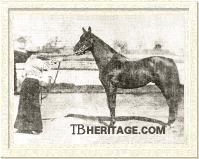
"Two English Celebrities" Lily Langtry and Ormonde at Rancho del Paso in 1904, shortly before his death
| |
On Saturday, May 21, 1904, at the age of 21, facing increasing difficulty in breathing, and a sudden onset of partial paralysis, Ormonde was mercifully destroyed and buried at Macdonough's stud in California, but was later exhumed, and his bones returned to England, where they were put in display at the Museum of Natural History in Kensington. Even if he had never gotten a single foal, he would be enshrined as one of the best racehorses of all time, and one of the most-travelled. But his son Orme cemented his place in a great many of pedigrees of thoroughbreds today through his ever-branching descendants.
--Patricia Erigero
|
|
|
|

